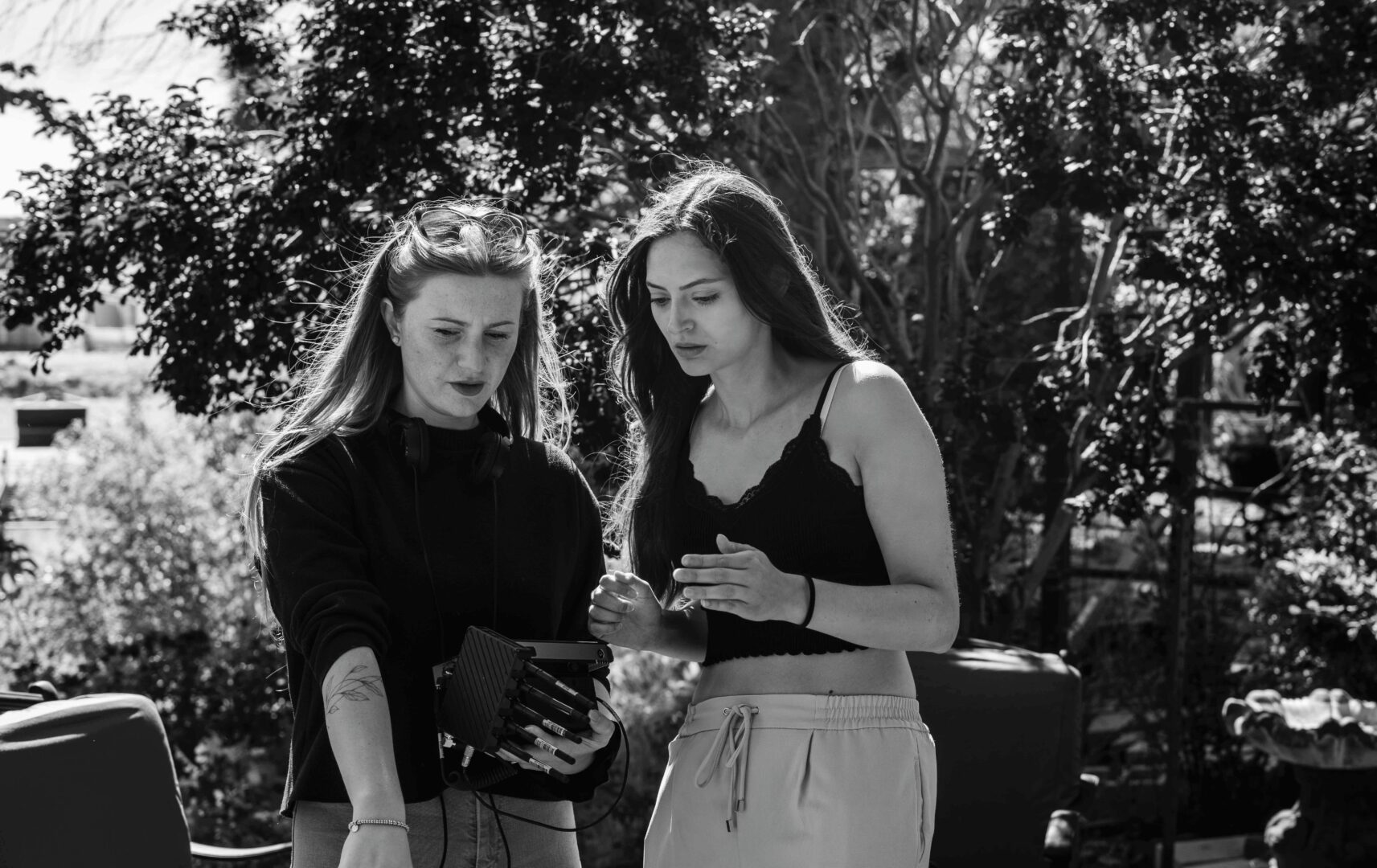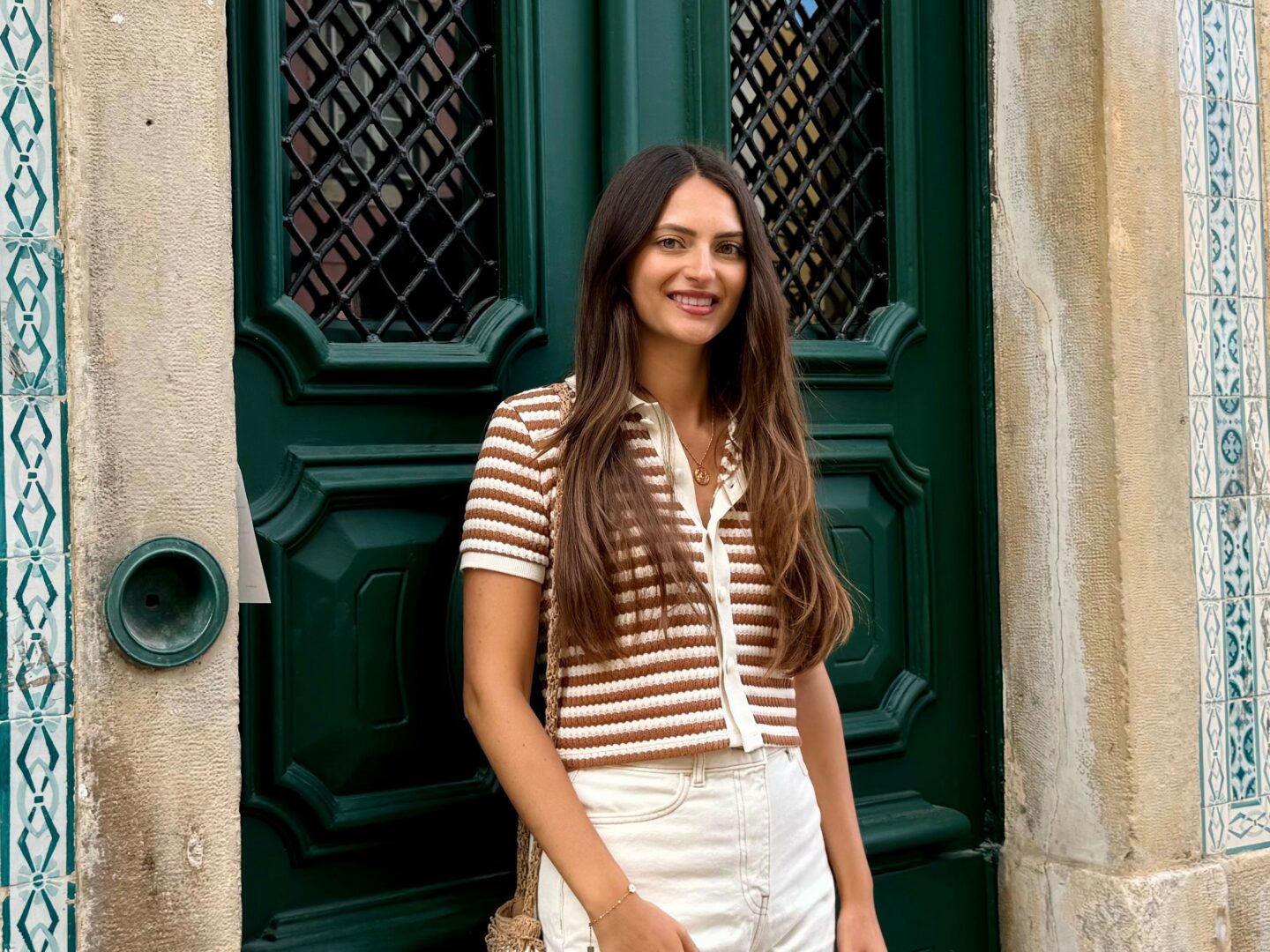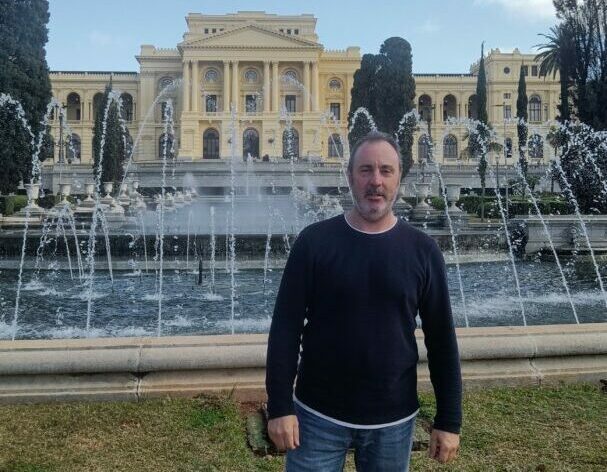We recently connected with Michelle Künzler and have shared our conversation below.
Michelle, so excited to have you with us today. So much we can chat about, but one of the questions we are most interested in is how you have managed to keep your creativity alive.
For me, creativity is a fluid and dynamic process. As a production designer, I go through phases where ideas flow effortlessly and others where I struggle to come up with new concepts. To avoid these creative roadblocks, I practice several strategies that help spark my creativity.
One of those strategies is going on walks, observing my environment, and taking in the details around me. Visual stimuli are particularly helpful in giving me ideas for production design. These moments of observation often translate into new ideas for colors, textures, materials, and elements. For instance, while working on my film “Sequoia”, an award-winning sci-fi thriller short, I spent time walking around Burbank, looking at suburban homes. This inspired the setting of the film in a seemingly idyllic suburban neighborhood, a choice that visually conveyed the tension between false comfort and an underlying sense of danger. As both the director and production designer of “Sequoia”, I was particularly drawn to the idea of shooting in a white mid-century modern house, which perfectly complemented the suburban setting and the story’s domestic subthemes of outdated gender roles and sexist AI designs.
I also believe that seeking inspiration from diverse sources, such as visual references from movies or the sets I work on, is key to fostering creativity. Watching films and analyzing their production design helps me understand how other production designers use space, color, and props to enhance storytelling. Since “Sequoia” was set in a suburban neighborhood, I was inspired by “Desperate Housewives'” Wisteria Lane and the sets of “The Stepford Wives.” I also drew inspiration from sci-fi films like “Her” and thrillers like “Midsommar” to steer away from stereotypical sci-fi and thriller aesthetics.
Another valuable source of inspiration is collaboration with other creatives, which allows me to exchange ideas and gain new perspectives. Seeing how other production designers work and learning from their creative processes has informed my own approach to production design at times. While working on “Hunter”, a sci-fi western short produced by LORE Productions, I had the opportunity to serve as a props master under production designer Geneva Klein. Observing Klein’s approach to production design introduced me to new materials, textures, and design techniques, inspiring fresh ideas and concepts for the projects that followed.
Generally, I flourish in environments where ideas are shared and developed collaboratively, as opposed to working in isolation without anyone to bounce ideas off. In production design, collaboration is vital, as it involves coordinating with the art department and other key creatives, such as the director and cinematographer, to craft a cohesive vision.
Additionally, I’ve learned the importance of embracing spontaneity. Sometimes the best production design ideas come when I dive in without overthinking, letting the process unfold naturally. As the saying goes, “perfect can be the enemy of good,” and striving for perfection can stifle creativity. Making mistakes along the way often leads to unexpected discoveries and new ideas. Sometimes I start with one concept and end up with a completely different look. In fact, understanding what doesn’t work is often the key to uncovering what does.
This approach shaped my creative process while working on the branded content ad “Right on Top of That” for Almost Anything Inc., a Los Angeles-based elite personal assistant and errand service. Produced by Ragland Reign Productions, the commercial required me to design two contrasting sets: a messy executive office and an organized home office. Initially, I envisioned entirely different furniture, decor, and color accents for each space. However, through trial and error, I ultimately found the right design choices for both sets.
Another essential aspect of staying creative is research, which plays a critical role in production design. Once I have a vague idea for a project’s visual concept, I dive into research to get a better understanding of the historical, cultural, socioeconomic and aesthetic context of the story. This process refines and expands my vision, often sparking even more ideas, keeping the creative momentum alive. Proper research ensures that the environments I create are authentic, layered, and serve the narrative in the best way.
As a Swiss-Turkish production designer, I am familiar with my own cultures’ aesthetics, but projects set in unfamiliar cultural contexts have required me to expand my understanding through in-depth research. For the award-winning short films “Kool-Aid Stand” and “The Ally”, both set in African-American environments, I researched extensively to authentically depict a Black low-income household in “Kool-Aid Stand” and a Black-owned record label during Black History Month in “The Ally.” Similarly, I studied Indian culture and aesthetics to create the production design for the Indian drama shorts “Echoes of a Dream” and “Secrets of an Empty Frame.” For the festival-selected drama short “Umit”, I explored Kazakh culture to ensure an accurate portrayal. This dedication to research has not only helped me create visually compelling and culturally authentic designs, but has also led to recognition at festivals, such as the praise “Umit” received for its production design at the 28th LA Shorts International Film Festival 2024.
Ultimately, production design is about storytelling through visual elements. By staying open to inspiration, embracing collaboration, and allowing room for experimentation, I am able to craft sets that resonate with audiences and enhance the narrative.


Thanks, so before we move on maybe you can share a bit more about yourself?
Originally from Switzerland, I am a Los-Angeles based filmmaker, specializing in screenwriting, directing, and production design. I have written and directed multiple short films, including my most recent project, “Sequoia”, a sci-fi thriller exploring the interplay between advanced technology and gender roles. Currently on its festival run, “Sequoia” has enjoyed success, winning the Best Student Film Award at the 16th Los Angeles Reel Film Festival and being shortlisted for the Watersprite Film Festival Screenplay Award, among others.
While I am deeply passionate about writing and directing, my current focus is on my newfound interest: production design. What excites me most about this job is the process of bringing concepts to life on screen, transforming abstract ideas into tangible sets that immerse audiences in the story. Both conceptualizing a project’s look in pre-production and executing that vision during production are incredibly fulfilling. I love the initial moment of brainstorming, the journey from exploring different ideas to shaping and finalizing the visual concept, and then dressing the set, watching everything come together like a puzzle—it’s a truly satisfying experience.
I am driven by a passion for meaningful storytelling. I view production design as more than just aesthetics, but as a powerful narrative tool. For me, production design is where storytelling truly comes alive visually. It helps deepen the story, establish characters, and create a world that resonates with the audience. What makes production design—alongside wardrobe—so special, in my opinion, is its ability to embody the essence of “show, don’t tell.” Through visual storytelling, production design communicates so much—tone, setting, time period, a character’s background and inner life—without a single word, making it an essential element of cinematic storytelling.
While its narrative function is crucial, I also love and value the aesthetic side of production design. Creating and looking at visually stunning sets is something I truly enjoy. I am especially drawn to feminine, whimsical, playful, and highly stylized sets filled with vibrant pastel colors, contrasting textures, and intricate details. My dream is to one day design sets as breathtaking and imaginative as those in “Poor Things”, “Barbie”, or “Wicked.”


There is so much advice out there about all the different skills and qualities folks need to develop in order to succeed in today’s highly competitive environment and often it can feel overwhelming. So, if we had to break it down to just the three that matter most, which three skills or qualities would you focus on?
Looking back, the three qualities that have been most impactful in my journey as a production designer are resourcefulness, attention to detail, and collaboration.
Resourcefulness, adaptability, and problem-solving skills have been key in overcoming challenges like time and budget constraints in pre-production or unexpected problems on set, allowing me to quickly find creative solutions with limited resources. My advice to those starting out is to embrace constraints as opportunities for innovation and experimentation. Obstacles often spark creativity. For instance, on “Beyond Doubt”, a drama short directed by Andre Forrest, I repurposed paper waste and wrapping paper originally used to transport props, transforming them into modern wall art that turned an empty wall into an aesthetically pleasing backdrop. Similarly, while working on “White Coat”, a medical drama short produced by MVPSTYLN Productions, I had to improvise when asked to set a table for a dinner scene without the necessary props as there was no time to acquire food. With lunch leftovers unavailable, I quickly came up with the solution to use tea bags and creamer from the crafty station to create fake soup, ensuring the scene came together seamlessly.
Another key factor in my journey has been my attention to detail. My thoughtful and precise approach to production design has helped me craft environments that feel rich and authentic. This precision is embedded in my creative process from start to finish. It begins with in-depth research, where I study specific historical time periods, socioeconomic backgrounds, or cultural contexts relevant to the script, ensuring accurate representation. Ultimately, it ends in the way I meticulously dress the sets during production, where attention to detail means that every element—whether it’s prop selection and placement, composition of the shot, or color symbolism—adds depth and authenticity to the set. Before finalizing the set dressing, I always check the monitor to make sure every detail looks perfect as I ask myself questions like: “Do the decorative objects look stacked in the frame?” If so, I reposition them. “Does the wall still look too bare?” Yes? Let me add more wall decor then. This final check provides the clarity I need to ensure that the sets not only feel complete and visually compelling, but also maintain continuity throughout production. It’s important to pay close attention to the world around you and observe how everyday objects and spaces tell stories and apply that to your designs.
Lastly, collaboration is at the heart of successful production design. It’s a team effort, and working closely with directors, cinematographers, and other departments is essential for creating a cohesive vision. My advice is to always stay open to feedback and actively engage with others, and be willing to learn from different perspectives. As mentioned earlier, through my experience as props master on “Hunter”, I gained valuable insights into production design by learning from production designer Geneva Klein. Similarly, on the drama short “My Story in Hollywood,” working with art director Fernanda Arana was both refreshing and creatively stimulating, as brainstorming with her in the face of on-set challenges as well as observing and learning from her creative process further expanded my creative horizons. By being receptive to the expertise of other creatives, I have honed my skills and deepened my understanding of the craft.


We’ve all got limited resources, time, energy, focus etc – so if you had to choose between going all in on your strengths or working on areas where you aren’t as strong, what would you choose?
Reflecting on my journey as a filmmaker, I believe I should have explored several roles before specializing in one. As a director, having a basic understanding of each department is incredibly valuable since you’re overseeing the entire production and making decisions that influence every aspect of the project. Filmmaking is a collaborative effort, and while directors receive assistance in decision-making from the other department heads, the more you know about production design, cinematography, sound, and other areas of filmmaking, the easier it becomes to tell a compelling, well-rounded story. That said, to build a career and establish yourself, it’s helpful to specialize in one or two areas only.
During my Master’s studies at the New York Film Academy in Los Angeles, I discovered that my strength lies in production design, which I have chosen to prioritize for now in order to refine my skills. By dedicating myself to production design, I’ve been able to gain deeper expertise and develop a more professional approach to my work. Over time, I have come to deeply appreciate the crucial role of production design in crafting visually striking and immersive films that silently communicate narrative information through rich visuals. I have also developed a profound respect for the intricate process behind production design, from the meticulous planning in pre-production to its time-sensitive execution during production.
While specializing in production design has allowed me to gain experience more quickly, I believe it’s beneficial to stay curious and invest time in other areas of interest. I’m particularly drawn to screenwriting and editing, and I plan to explore these fields further in the future. However, I understand the importance of only focusing on areas that align with my strengths and long-term goals, rather than delving deeply into as many areas as possible. In my case, I know that the more technical areas such as production sound mixing, camera, and lighting are not my strengths, and I don’t feel it’s worth pursuing them in-depth, as they don’t come naturally to me. On the other hand, screenwriting and editing are areas I feel more inclined toward, so I see greater potential in developing those skills. Ultimately, it’s about recognizing where your strengths and passions lie and investing your time and energy there, while still keeping an open mind to growth in other fields.
Contact Info:
- Website: https://mikuenzler.wixsite.com/michelle-k-nzler—w
- Instagram: https://www.instagram.com/mck_movies/
- Linkedin: https://www.linkedin.com/in/michellekuenzler
- Other: Michelle Künzler – IMDb: https://www.imdb.com/name/nm15486752/?ref_=hm_rvi_i_3
Sequoia – Website: https://www.sequoia-shortfilm.com
Sequoia – Instagram: https://www.instagram.com/sequoia_shortfilm/


Image Credits
– Los Angeles Reel Film Festival
– Özne Göçen
– Bauyrzhan Sayakhmet
– Weijie Liu
– Robert Nguyen
– Suriya Nikhil
so if you or someone you know deserves recognition please let us know here.




